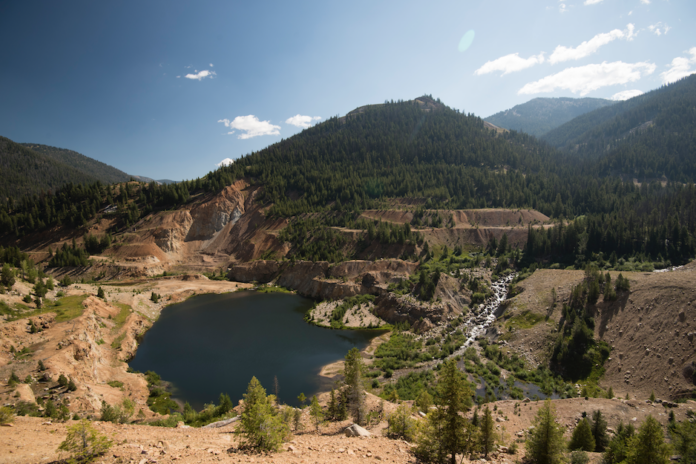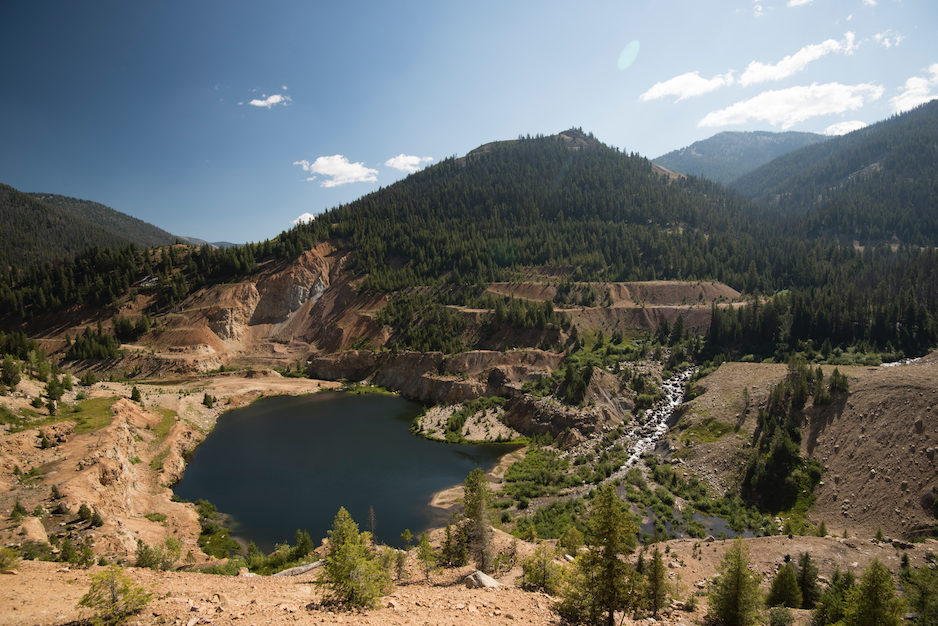Tucked in the mountains of Valley County in a small town just east of Yellow Pine is the Stibnite Mine District. The district was mined for more than 100 years, dating back to 1899 before closing. Now, a proposed project looks to reopen the mine.
Perpetua Resources, formerly Midas Gold, wants to open the mine again with the Stibnite Gold Project to primarily mine for gold and antimony but also some silver. Antimony is commonly used to make bullets and batteries.
According to Perpetua Resources, during World War II, Stibnite Mine District provided 90% of the antimony and 50% of the tungsten for the U.S. The site was mined up until 1996 but has since sat vacant.
After years of project refinement and 10,000 public comments following the Forest Service’s Supplemental Draft Environmental Impact Statement, or SDEIS, Perpetua’s Modified Mine Plan was released to the public.
The Stibnite Gold Project is weighty, encompassing more than 1,700 miles. Perpetua wants to clean up the mining district that has tailings and waste from decades ago and again give the U.S. access to a critical mineral. But opponents say this project would further damage the environment. And Valley County officials are split on whether the mine would help or hurt the area.
The proposal
Cleaning up and mining too?
The updated plan incorporates water management and closure activities that aim to reduce the duration of long-term water treatment requirements. It has a measure to manage stream temperatures and reduces potential impacts with access, transportation, and hazardous materials on alternate routes to the mine site.
The project footprint is 1,740 acres. Perpetua owns 505 acres; the rest is public land. With the alternative plan, Perpetua’s timeline would include three years of construction, 15 years of operations, and five years of reclamation.
“Most of (the public comments) supported the project. We really heard three things. We heard that there should be an opportunity to reduce the project footprint, that we should identify ways to reduce water temperature, and we should also identify ways to improve water quality so that permanent water treatment was not needed,” Mckinsey Lyon, Perpetua Resources VP of External Affairs said. “We listened to those comments and identified and then sent back to the Forest Service plan revisions that would help improve environmental outcomes and address those three things.”
Perpetua claims the project would clean up the mess it says was left by the miners before current regulations.

“Today we have a situation where there are ten-and-a-half million tons at base minimum of tailings and waste that are degrading water quality to the point that we get readings of arsenic in groundwater at 700 times the drinking water standard,” Lyon said.
The SDEIS shows that through the Stibnite Gold Project, the amount of arsenic in the East Fork South Fork of the Salmon River would be lowered by 47%.
“That is a remarkable and really fairly dramatic improvement in water quality,” Lyon said. “It also shows that by opening up fish migration once again, the Forest Service concluded that there would be a major permanent, regional, and beneficial effect on Chinook salmon, steelhead, and bull trout. So concluding that through the project, we would enhance habitat and access to fish habitat in a way that would benefit the species. It also shows that we don’t need permanent water treatment anymore and that we’ve lowered water temperature by five degrees celsius.”
The East Fork South Fork Salmon River flows into an abandoned mining pit. This blocks salmon, bull trout, steelhead, and chinook migration up to 20 miles of habitat. Perpetua says fish have been unable to swim past the Yellow Pine Pit since 1938.
“We’ve designed our project to try to front-load addressing these environmental legacies that were left behind while re-mining it for gold and antimony,” Lyon said. “And we’ve done a lot of work since 2010, both to understand the geology and mineralization of the site and understand how the environment is behaving today at Stibnite.”
Gold — and antimony
The U.S. does not currently have domestic access to antimony trisulfide, and the Stibnite district is the only known reserve on American soil. The Department of Defense awarded Perpetua up to $24.8 million to get started on the Stibnite Gold Project.
“The United States hasn’t had a supply of antimony trisulfide domestically since Stibnite shut down decades ago,” Lyon said. “And so we’ve been reliant on foreign sources, and that’s an unstable supply. And right now, we don’t have access to antimony trisulfide. And that’s really important because antimony trisulfide is primarily used in primers. So it is a part of the energetics system of defense munitions.”
Lyon said that some people who oppose the project have “minimized” the importance of antimony. She said they have heard comments about the antimony quality and that there is not “very much” available.
“This reserve of antimony, as I mentioned, is not only the only identified reserve in this country, it is the largest reserve in the world, not owned by China and Russia,” she said. “So that is extremely significant. Secondly, it is a very pure form of antimony that is very rare; it is low impurity. We believe that because it produced antimony at the level that was required for defense decades ago, called mil-spec. You have to get it to the right formulation called mil-spec… that we can get to mil-spec again, likely without any additional processing needs.”

Lyon concluded that if our country “needs” to mine on U.S. soil, an abandoned mine site would likely be the best option.
“It was the idea that we do need to mine in this country. It’s the first link in our every single supply chain from clean energy to national defense,” Lyon said. “So if we do need to mine here, wouldn’t going back to an abandoned mine site be the right approach? Especially when we can design a plan that addresses those legacies. And really takes them on and says we will find the solutions for this place that has been abandoned that no one has been willing to step forward and provide the help that it needs.”
Perpetua has signed an agreement with federal agencies that said it would remove and safely store 325,000 tons of legacy tailing and waste.
The politics
Cascade’s mayor: in support
Cascade Mayor Judith R. Nissula favors moving the Perpetua Gold Project forward. Nissula said she doesn’t “foresee” much of a negative environmental impact.
“I feel really, really good about them mitigating any negative impact, but I don’t foresee any real negative impact,” Nissula said. “And I think it’s just way different than it was, ten years ago, 20 years ago, 30 years ago. I think there are measures in place that the federal government and state government… I think there are enough safeguards in place that’s going to ensure that there are no environmental impacts.”
Nissula said that from her eyes, the community has been supportive of this project, and she has not heard many negative comments from the residents of Cascade. She praised the company for being responsive and communicative throughout the process.
“I feel the company cares, and I deal with all sorts of different factions, public, private, and whatnot, and not all of them do as good a job at staying informed, or stay keeping the city informed, reaching out,” she said.
Nissula said that she thinks this project would positively contribute to the economy.
“I’m under no illusion that there’s going to be a big influx of people who are working there,” she said. “… But I believe that there are going to be businesses translated into the city and may even bring some uniqueness to something that the city doesn’t have right now. And we’re right there. Things are so different now than what they were 20 years ago with respect to a big employer coming in…. We have people that are coming in and out of there, and they’re using local resources, grocery stores, and everything else, even though they’re living on-site. They still bring money into the city.”
McCall’s mayor: opposed
This has not come without controversy from local tribes, conservation groups, and some Valley County residents and officials.
McCall is the most populous city in Valley County, with 3,453 residents recorded during the 2020 census. McCall officials who have spoken out have largely been against this project from the start. A multi-page letter penned to Perpetua and signed and approved by the city council members and the mayor highlights issues the city sees with the SDEIS and the Stibnite Gold Project.
A concern reported is an influx of traffic going through McCall.
“It’s our understanding in a thorough review of the supplemental DEIS that there’ll be some mining traffic, perhaps as much as a third going through our residential neighborhood to get over Lick Creek Summit.” McCall Mayor Bob Giles said. “…The main traffic will be going through Cascade and the Warm Lake highway and then on to the mining site. But not all of it. So this really concerned us because our residential neighborhoods have narrow streets, they weren’t designed for… more samples or heavy trucks carrying heavy loads, or perhaps hazardous materials might be hauled through there.”
McCall is a town that relies on tourism – one of the major contributors to the local economy. A one percent local option tax helps pay for repairs and upgrades to city streets. That one percent is a big part of the city’s budget. Giles said the amount is in the ‘neighborhood’ of $2 million a year, and he added that it’s “mainly paid by tourists.”
“If all of a sudden our main tourist route to the Middle Fork of the Salmon River or to go visit the site of Big Creek where airplanes land (has an increase in traffic)…we want to make sure that some people that are experts at that analyzed the possible effects. Because our thoughts are that it may interfere with our tourism and our ability to have people go out into the backcountry, which would affect us economically,” Giles said.
Perpetua’s evaluation shows that this mine would bring jobs to Valley County, therefore boosting the economy. However, Giles pointed out that these jobs would be fairly high paying, adding more housing competition in an already struggling area.
Giles expressed concern that bringing in high-paying jobs over a 20-year period will increase competition and drive a housing supply imbalance.
“Those jobs are going to be fairly high paying, and we have a concern about the competition for housing,” Giles said. “Not all of the housing will be on site, is my understanding way out in the woods. A lot of it will be spread out in Valley County, and I suspect some of it will be in McCall… our citizens are really having a hard time finding affordable rentals… There’s a very short supply of rentals that are affordable, like entry-level employees and young families, for example, with two incomes, are struggling to find that kind of housing. The same thing with purchasing a house. The purchase price of homes in Valley County and specifically in McCall have gone up considerably where we’re already in trouble.”
Perpetua’s 2020 feasibility study said during the construction period; the project would employ approximately 594 people, about 583 people during operations, about 160 during reclamation, and around 44 people post closure.
They estimated local jobs represent about five percent of the total workforce, with “typical” annual wages of around $70,000.
Third parties weigh in
Idaho Conservation League questions restoration claims

John Robison, the Public Lands Director for the Idaho Conservation League, said the company “embraced” the restoration component with outreach and public relations – but there is a problem.
“But the mine plan seems to follow the track of an old school open pit, cyanide heap leach,” Robison said. “So we are very concerned about the direction the project is going and the risk that it poses to the South Fork Salmon River watershed.”
He said that while on paper, properly restoring historical mine waste to prevent arsenic from leaving the site sounds good, the material would be dumped in “pristine areas.” The conservation league is also worried about how Perpetua proposes to open the fish passage at Yellow Pine, citing that some of the “important spawning area” would be lost if the project moves forward.
“The problem is that they’re going to be scooping this material up and then dumping it in pristine areas as part of the larger mine plan,” Robison said. “So you’re essentially taking a bunch of mine waste and moving it into undisturbed areas and trying to call it restoration. So a couple of things that would happen on site if that mine plan goes according as proposed is that you’d have one area, particularly upper Meadow Creek, that serves as critical habitat for bull trout, and that drainage would be buried under 100 million tons of mine tailings. While there is a vision to restore the stream up on top of the mine tailings, there’d be a 400-foot elevation drop, so that stream would no longer be accessible to fish.”
Another concern Robison said they have is water quality and water temperature. He noted that Perpetua’s vision of the area post-mining is “compelling.” He added that this was an effective way to gain the support of the public – but they see a significant issue with this.
“The problem is that under the best-case scenario, it would take 100 years for those streams to be restored. And the other thing is that according to the draft environmental impact statement, they don’t have enough soil to restore the streamside vegetation that’s needed,” he said. “And so that really lovely vision of a restored site… It doesn’t look like the mine plans gonna get you there. And the soil that they have located is really high in arsenic, and there are concerns about the ability for plants to grow in that soil.”
He continued saying the plan would “delay recovery.”
“So Perpetua has a really fantastic-sounding vision for what the site would look like when they’re done,” Robison said. “The problem is that the mine plan, instead of getting us there in a timely fashion, I think actually delays recovery and actually, in the long term, makes this site worse than it is now.”
Perpetua talks about restoring the salmon habitat – but Robison said there is not enough vegetation on the site to support this.
He said that the piece about increasing the amount of bull trout, cutthroat trout, salmon, and steelhead “might be a true statement.” Though, the analysis shows that the water temperature would actually be too hot for fish to swim during spanning times.
“So it’s the equivalent of… let’s say someone wants to remodel your house, and they do a fantastic job, but you can’t live it during three months of the summer because there’s no air conditioning,” Robison said. “So that’s kind of what’s happening up here. They have a great vision for the area in terms of the foundation of some of the streams, but the other things that fish need to survive there are lacking and won’t be there for centuries, if ever.”
In the Fisheries Specialist Report, it said that when the mine closes, a decrease in the quality and quantity of bull trout habitat would take place.
“Post-closure, a net decrease in quality and quantity of bull trout habitat would occur despite removal of passage barriers and an increase of lake habitat for bull trout,” the Fisheries Specialist Report said.
Questions about waste
The SDEIS also said that 3,000 truckloads of hazardous materials would travel through Eagle and Cascade or New Meadows and McCall every year. These loads would include up to 8.5 million gallons of petroleum products, 7,300 tons of ammonium nitrate, and 4,000 tons of sodium cyanide.
“The city is highly concerned about any hazardous material spills in our jurisdiction and specifically into the North Fork Payette River and the Big Payette Lake,” The City of McCall’s letter said. “The McCall area fire departments do not have a HazMat Team nor the proper materials to respond to, contain, or clean up a spill. According to the McCall Fire District Chief, the closest HazMat Team is a minimum of four hours away, and McCall Fire is only equipped to issue evacuation notices and clear the scene while waiting for a HazMat Team to arrive. Four hours is a substantial amount of time for hazardous materials to spread into the North Fork of the Payette River and into the air over a populated area.”
The Idaho Conservation League wants to see the Forest Service return to the “drawing board” with Perpetua and make some revisions.
“We want to see the forest service go back to the drawing board with Perpetua and come up with a plan that’s limited to the existing footprint to see if that addresses concerns,” Robison said. “And really, what we want to see is a path forward that restores this important watershed without increasing the short-term and long-term risks. The Idaho Conservation League supports responsible mining, but that means that we have to make sure that projects are designed to first avoid the impacts instead of relying on wishful thinking to make things better 100 years later.”
Nez Perce Tribe against concept
The project is located within The Nez Perce Tribe’s homeland.
The tribe who has lived on this land for thousands of years does not view this mine as a benefit to them or the fisheries. Back in 2018, the tribe adopted a resolution that opposed the project. The tribe is still opposed. In a letter to the forest service, the tribe lays out its issues with the project.
“As documented by the forest service in the SDEIS and the tribe’s comments, the project will prevent tribal member access to usual and accustomed fishing places, hunting and gathering areas, and culturally significant places for twenty years or longer,” The Nez Perce Tribe’s letter said. “It will also irreparably harm salmon, other treaty reserved aquatic species, and essential fish and wildlife habitats as well as impacts the tribe’s fish management restoration efforts in the East Fork South Fork Salmon River.”
This included the tribe saying that the project’s story map left out essential information relating to the environment. The tribe also requested a 120-day comment period, which is allowed by the forest service, but the tribe was not granted it.
The most recent comment period for the SDEIS was 75 days long. Before that, during the National Environmental Policy Act process, there was a 45-day public comment period in 2017 and a 75-day comment period in 2020 on the DEIS.
“The project story map leaves out essential information about the affected environmental and environmental consequences including but not limited to impacts to wildlife and wildlife habitat vegetation (e.g., Endangered Species Act- threatened whitebark pine), and soils,” the letter said. “These omissions, as well as over 30 other technical documents integral to the forest’s analysis in the SDEIS, were not provided to the tribe or public until weeks into the comment period. This delay has hampered the tribe’s review during the already short review period.”
What’s next
Perpetua Resources is still moving through the NEPA process, which the U.S. Forest Service leads. The USFS is currently reviewing the comments submitted during the comment period on the SDEIS and is finalizing the schedule for the remainder of the NEPA process. Perpetua anticipates a Final Environmental Impact Statement and draft Record of Decision in mid-2023.







